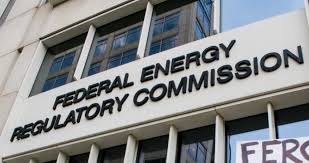Attorneys general from 11 states ramped up pressure on the Federal Energy Regulatory Commission (FERC) to recognize state policy goals as it makes decisions related to market design, siting of new gas pipelines and storage facilities, and grid reliability.
The measure is the latest in a string of recent pushes by states to ensure federally regulated regional transmission organizations (RTOs) and the competitive electric markets they operate will accommodate subsidized resources like renewable and nuclear power.
But they further complicate decisions at FERC, which has made clear its interest in maintaining the integrity of markets it regulates, ensuring prices are competitive and sufficient for new entry, and protecting markets from adverse impacts of oversupply.
States: Seeking High Prices Not ‘Just and Reasonable’ as Public Priorities Evolve
The attorneys general for California, Connecticut, District of Columbia, Delaware, Maryland, Massachusetts, Michigan, North Carolina, Oregon, Pennsylvania, and Rhode Island—states that fall within wholesale markets operated by PJM Interconnection, ISO-NE, and CAISO—told FERC’s three commissioners in an Oct. 28 letter that the federal regulator’s actions significantly affect state abilities to achieve clean energy and climate goals.
The letter specifically asks FERC to consider promoting market design choices that “appropriately recognize the states under the Federal Power Act to shape their resource mixes,” stressing, it is “not just and reasonable” to seek high prices to maintain competitiveness of power plants that are aging, uneconomic, or emit higher pollutants “by discriminating against state-supported cleaner technologies.”
The attorneys general also urged the commission to “eliminate barriers to competition” for renewable generators, energy storage, energy efficiency, demand response, and other technologies. As it evaluates new pipeline infrastructure, FERC should also “comprehensively assess the associated climate impacts” and clean energy alternatives. Finally, FERC should exercise its oversight authority to ensure RTOs and other entities are “fostering participation, transparency, independence, and responsiveness to states, consumers, and other stakeholders,” they said.
“Decisions made today will shape the electricity system for decades to come,” the attorneys general wrote. “Now, more than ever, it is essential for the states and the Commission to work together to ensure that the Commission’s actions advance, not impede, state policies and prerogatives.”
FERC’s Biggest Challenge: A Fine Balance
The letter from the states’ top legal officers is noteworthy because it indicates states will defend their energy rights against the responsibility to regulate interstate transmission and wholesale sales of power granted to the federal agency by the Federal Power Act (FPA).
As a September 2019 report from New York University’s School of Law suggests, state attorneys general have been pivotal in achieving state priorities in this space. State rights to back generation that meets specific environmental, economic, or political goals, for example, were recently upheld in two federal appeals court decisions regarding nuclear subsidies in Illinois and New York. Those decisions have emboldened Connecticut, New Jersey, and Ohio to enact nuclear subsidies, and Pennsylvania, at least, to consider similar measures.
But states also played a key role in the successful pushback against the Department of Energy’s September 2017 Notice of Proposed Rulemaking, a measure that would have required FERC—an independent regulatory government agency that is officially organized as part of the DOE—to exercise its authority under the FPA and force RTOs and ISOs to “establish just and reasonable rates for wholesale electricity sales” for power plants that show “reliability and resiliency attributes,” such as coal and nuclear plants. FERC nixed the rule, saying that it didn’t satisfy the FPA’s mandate that tariffs are not “unjust, unreasonable, unduly discriminatory or preferential.” But while it moved to terminate the proceeding and initiate a new docket to evaluate the resilience of the bulk power system in regions operated by RTOs and ISOs, FERC hasn’t acted on the measure yet.
Damaging Uncertainty
As FERC’s commissioners have often expressed, the federal entity recognizes the complexity of its challenge to balance competitive market integrity and state policies. But despite a technical conference it held in May 2017 to explore the issues, FERC’s messaging has been mixed, and it is unclear how it will proceed to address them.
In a May 2018 brief filed with the U.S. Department of Justice in the Illinois nuclear case in the Seventh Circuit, for example, FERC essentially argued that zero-emission credit (ZEC) programs to prop up uneconomic nuclear plants do not preempt the FPA. Yet in a pivotal 3–2 decision on June 29, 2018, FERC rejected approaches by PJM to reform its capacity market, even as FERC acknowledged that the capacity market’s integrity and effectiveness is increasingly and “untenably threatened” by state subsidies for preferred generation resources. (In a capacity market, lowest-cost generator bids for power are chosen first.)
RTOs have responded to FERC’s concerns in different ways. ISO-NE adopted the Capacity Auctions with Sponsored Policy Resources (CASPR) to coordinate timing of the entry of new “sponsored policy resources” with retirements of existing resources. NYISO, which already had the “buyer-side mitigation” rule in place to address out-of-market entry of certain resources in certain capacity zones, is exploring a carbon price. And on Oct. 3, the entity released a study conducted by the Analysis Group that found that the carbon price—which would be based on a state-established “social cost of carbon emissions”—would create “efficient market incentives for owners to invest in maintaining well-performing existing facilities with zero- and low-carbon output, and in repowering under-performing generating units, while hastening the retirement of less-efficient and uneconomic fossil units.”
The most-watched measure, perhaps, is PJM’s response to FERC’s order that required it to modify its capacity market rules, specifically its Minimum Offer Price Rule (MOPR), in response to concerns that state policies like renewable energy credits and ZECs were suppressing prices in the capacity market.
PJM filed two new approaches on Oct. 2, 2018 that it said were designed to recognize state authority to shape the makeup of their generation fleet. The first involves a coupling of the expanded MOPR and a Resource Carve-Out (RCO) construct. The proposed expanded MOPR would apply to all fuel and technology types and to both new and existing resources (the original MOPR only applied to new gas-fired units). The RCO gives states the alternative to remove state-subsidized generation assets (which are subject to MOPR) from the capacity market. The RCO would then allow subsidized resources to obtain a capacity commitment without having to clear the capacity market. The second option is what PJM calls an “extended RCO”—and it would combine the RCO with a mechanism to restore the market clearing price to the most economic, “correct” competitive level. The extended RCO would also include price formation rules to thwart price suppression, which could result if the RCO stood alone.
However, though FERC had initially committed to issuing replacement rules by January 2019, the measure remains in limbo. Compounding FERC’s inaction is that the five-member commission is currently functioning with only three commissioners, following the death of Commissioner Kevin McIntyre in January 2019, and the August 2019 departure of Commissioner Cheryl LaFleur. Commissioner Richard Glick, meanwhile, is recused from the cases until Nov. 29, 2019, owing to an ethics pledge that bars him from working on cases involving his former employer Avangrid.
But the uncertainty has had major implications: PJM on Oct. 1 confirmed suspension of all deadlines and activities related to the base residual auctions for the 2022/2023 and 2023/2024 delivery years. PJM could also suspend approaching deadlines for the auction to be held in 2020, it has suggested.
With FERC paralyzed, and thwarted by the courts, industry is reaching out to state legislators and regulators, as well as to Congress, to tout the benefit of market-based mechanisms. In September, for example, the Electric Power Supply Association (EPSA)—a trade organization that represents some of the country’s largest independent power producers, and a group which suffered a crippling legal defeat in its fierce fight against nuclear subsidies in the federal courts—urged House members to consider competitive, technology neutral market-based mechanisms as the best solution to sustainable environmental progress.
“Market-based mechanisms will yield the most efficient, lowest-cost set of resources and technologies that jointly produce the greatest environmental benefit while maintaining reliability,” it told the House Committee on Energy and Commerce in response to a plan House Democrats have proposed to achieve a 100% renewable economy by 2050.
States Urge PJM to Give Them a Voice
Also notable is that states are pushing for influence within the RTOs themselves. On Oct. 21, for example, the Organization of PJM States Inc. (OPSI), a 2005-established intergovernmental organization representing utility regulatory agencies from 14 jurisdictions within PJM’s 13-state footprint, called for a strengthened role in engaging in and influencing PJM rules.
“Enhancements to the PJM decision-making process could significantly increase states’ role, improve outcomes, benefit wholesale and retail customers, and reduce the need for rulemaking challenges and litigation,” it noted. “Options include soft change, rule or tariff changes to increase states’ role in PJM decision-making, and giving OPSI the rights to make filings with FERC under Federal Power Act Section 205.” On the structural side, it proposed changes to the operating agreement, reliability assurance agreement, or open access transmission tariff, which would “enhance PJM states’ influence on PJM rules and tariffs.” Yet another option it proposed was to “allow states to become members of PJM.”
OPSI lamented states within PJM’s footprint have no Section 205 filing rights or any formal advisory role, unlike states within the Southwest Power Pool (SPP), which hold authority over resource adequacy. States in SPP—as well as in MISO—are mostly vertically integrated, which means public utility commissions play a greater role in determining power profiles and capacity needs, whereas in PJM and ISO-NE, states are mostly restructured, it noted. And in ISO-NE, states participate in stakeholder processes, including providing input on proposed rules and tariffs revisions, through the New England Committee of States on Electricity.
PJM’s capacity market has evolved in numerous ways since it became a RTO in 2001, when its capacity market was “truly residual and voluntary (much like MISO’s capacity construct), and only provided for the voluntary exchange of capacity between its members,” OPSI said. Over the last decade, it has changed so that nearly all capacity in PJM follows PJM’s standards and requirements. But those rules have had a “large impact on both consumers and supply resources, and by extension, state interest,” it argued.
The expanded MOPR that would correct for price suppression from state policies, for example, could cost consumers in the region an additional $5.7 billion per year, OPSI noted, citing a report issued in August 2019 by Grid Strategies LLC. The report also concluded that more than 14 GW of renewable energy would be excluded from PJM’s auction under a broad MOPR policy, it pointed out.
Politicizing the Issue
State priorities, meanwhile, have also been championed from a broader pulpit in Congress. On Aug. 30, for example, 10 Senate Democrats wrote to to FERC Chairman Neil Chatterjee expressing concern with FERC’s “potential policy shift,” which they claimed, “could severely undermine state policies designed to support clean energy and address climate change.” The “policy shift,” they suggested was driven by “Republican FERC commissioners.” They added: “It is our understanding that the Commission’s now two-to-one Republican majority is considering moving forward a [MOPR] that would overrule existing rules that allow state-supported clean generation to participate freely in the PJM capacity market.”
Notably, the senators also cited the Grid Strategies report, pegging their concerns on the report’s claim that if the expanded MOPR is adopted, it could result in a $5.7 billion per year impact on consumers. The letter prompted EPSA in September to respond. In a letter of its own, EPSA told the senators that the Grid Strategies analysis “failed to consider the costs of the underlying subsidies at issue in the report,” saying the report’s “lofty” $5.7 billion per year figure was based on one of 14 scenarios in an independent market monitor’s (IMM) report that estimated “capacity price changes associated with the retention of uneconomic resources that would otherwise close, including over 17,000 MW of the aging coal fleet.”
EPSA’s claim prompted a rebuttal from Grid Strategies. “If anything, the MOPR is likely to cause larger capacity market price increases than the policy modeled in the IMM’s analysis, making $5.7 billion per year a conservative estimate of the MOPR cost,” it said.
As global consulting firm ICF noted in a July 2019 report, however, considering the large set of potential subsidy scenarios and proposed mitigation rules, “there is a wide range of possible market outcomes.”
Scenarios ICF tested on the 2021/2022 auction produced RTO prices ranging from $70/MW-day to $482/MW-day day. The RCO and extended RCO cases produce “very different clearing prices,” it noted. However, “Even with nuclear generators placed as price takers [that is, they bid at $0/MW-day], other resources such as coal-fired generators, new-entrant combined cycles, combustion turbines, and oil/gas steam generators still rely on capacity market revenues to recover their costs,” it concluded. For merchant generators, both the base RCO proposal and extended RCO proposal are “improvements on the current market design.”
“In the worst case, the base RCO proposal will not cause prices to be any more depressed than the status quo design, and due to the inclusion of a MOPR may result in some price improvement should some subsidized resources not be carved-out.” A more pronounced upside for merchant generators could come from extended RCO, it said, noting that proposal could result in higher capacity prices and incentivize new capacity construction.
—Sonal Patel is a POWER senior associate editor (@sonalcpatel, @POWERmagazine)

















